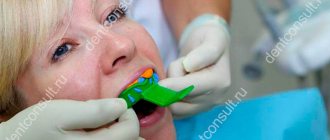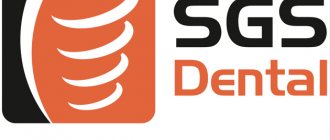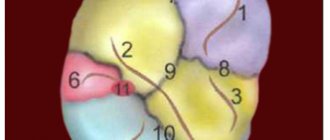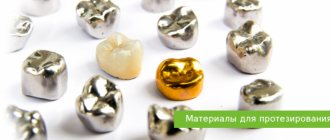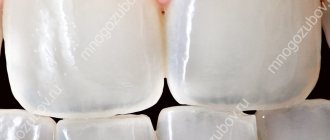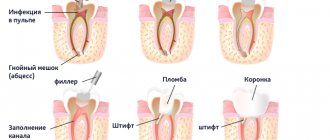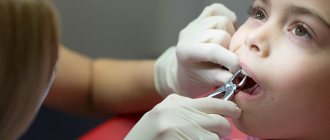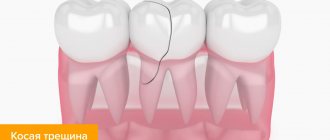Features of the procedure
In dental therapy, the silicone key method is an innovative solution. The technique reduces the time spent on restoration.
It is used to eliminate invisible dental caries. The cavity of the damaged unit is filled with a filling compound, and the last portion is given the correct shape using a template. Outlet channels are cut to prevent the composition from flowing.
It is possible to create an impression without a spoon. The work is carried out in stages, applying the composition layer by layer.
Remotherapy - what is it?
Remotherapy is a therapeutic and preventive measure aimed at replenishing the mineral composition of tooth enamel.
Remotherapy is carried out in a dental office and at home. This universal and effective procedure will help maintain the beauty and health of your teeth for many years. Remotherapy is carried out by applying a special composition to the surface of the teeth, which may include various phosphates, calcium compounds, fluorine, apatites and other substances that help the enamel return to a healthy state. Usually, to achieve the best therapeutic effect, remotherapy is carried out in several sessions.
Indications
Making a silicone key is indicated for certain conditions:
- rehabilitation period after traumatic injuries of individual elements;
- removal of outdated and damaged fillings;
- treatment of initial manifestations of carious damage;
- the need for aesthetic restoration.
A contraindication is a history of allergic reactions to latex.
Advantages and disadvantages
Positive results of using occlusal template technology:
- shortened recovery period;
- the relief of the palatal wall is close to the anatomical one;
- the occlusal plane is created perfectly;
- the contours between the cutting edges of the incisors and canines are symmetrical;
- controlled application of the composite;
- minimal final processing of the layer.
There are also a number of noteworthy negative factors:
- the rigidity of silicone does not allow reliably depicting micro anatomy;
- dental silicone is deformed when the composite is pressed;
- single-pack execution technique;
- difficulties in interacting with the silicone block due to the use of the cathedral.
Successive stages of restoration work
Restoration using latex template technology in stages:
- The doctor selects the color of the unit being restored.
- Shape modeling. Using wax, the shape of the tooth is reproduced on the model. The finished model is removed and serves as a prototype for creating a silicone template. The name of the technique is Wax-up.
- Mock-up. Direct modeling of the natural tooth shape in the patient's mouth.
- Making a key. The taken impression of the palatal surface serves as the basis for creating a template.
- Mock-up involves preliminary removal of the composite from the mouth. Then the carious cavity is prepared. If necessary, the enamel is cleaned from tartar. The doctor creates a bevel of the enamel layer.
- Teeth are cleaned with a brush and pastes with abrasive substances.
- Etching. The doctor ensures that the units are protected from saliva. Etching and application of adhesive composition are carried out.
- Fastening the template. A filling material of the selected shade is applied to the sharp edge. The created template is attached to the side of the sky wall.
- Applying the main shade of enamel. A special matrix is pre-installed to create the dental approximal surface.
- Application of dentin. The material is applied in layers, starting from the oral and towards the vestibular surface.
- Applying colored enamel.
- The hardened artificial layer is dried and cleaned by machine.
- Polishing with latex nozzles at low engine speed.
The created artificial incisor has a shade, function and anatomical specificity identical to a natural tooth.
What does the cost consist of?
The price of the procedure is determined by many factors. The cost is influenced by the raw materials, the professionalism of the doctor, the number of units being restored, and the equipment of the clinic. In private clinics with a decent level of service, the procedure is more expensive than in municipal dentistry.
The introduction of this method into dental practice saves dentists time and minimizes the risk of complications. The doctor reproduces the necessary relief of the palatal and occlusal surface. No occlusal-articulatory correction is required. At the same time, the key manufacturing method is characterized by simplicity, reliability and speed of execution.
Advantages and disadvantages of technology
Silicone template (key) technology allows you to achieve the following results:
- significant savings in recovery time;
- the palatal surface optimally matches the natural one, the occlusal plane is almost natural and suits the patient (at the final stage of restoration, some adjustment is required at the points of closure of the teeth);
- absolute symmetry along the contour between the cutting edges of the canines and incisors;
- controllability of the process of applying composite materials and, as a result, optimal thickness, requiring minimal finishing.
Not without certain shortcomings. These include the following factors:
- silicone is a hard material, which does not make it possible to fully display micro anatomy;
- silicone is subject to deformation when composite materials are pressed;
- work is limited to a single-pack execution technique;
- the use of latex fabric makes it difficult to work with the silicone block.
Recent developments use a carrier (applicator) and fluid composite materials, which allows you to get as close as possible to the anatomical structure when taking impressions.
Why does tooth enamel need remotherapy?
Tooth enamel has a prismatic structure consisting of hydroxyapatites, fluorapatites and other crystalline formations. Also, enamel contains various chemical elements and organic substances. There is a constant exchange between tooth enamel and human saliva: normally, saliva enriches the enamel with various substances necessary to maintain the integrity of the structure of enamel prisms.
If the pH of saliva, its mineral composition, quantity or consistency changes for any reason (the characteristics of saliva are affected by taking certain medications, cariogenic situation in the oral cavity, chronic diseases, smoking, pregnancy, etc.), this immediately affects condition of tooth enamel. The original components of the enamel structure begin to gradually wash out of it. Next, bicarbonate ions, hydrogen ions, and strontium ions are introduced into the enamel. They replace calcium, phosphates and fluoride, disrupting the optimal chemical composition of enamel hydroxyapatites and making it vulnerable. After some time, a carious lesion in the form of a white spot may appear on the demineralized enamel, or the person will begin to suffer from dental hypersensitivity. A timely course of remotherapy will help normalize the composition of the enamel and get rid of the consequences of its demineralization.
Remotherapy in the dentist's office
One of the universal methods of remotherapy in a dental clinic is coating teeth with an enamel-sealing liquid. Just one procedure is enough to increase the resistance of enamel to the action of cariogenic factors, reduce tooth hypersensitivity and eliminate defects on their surface. In the event that carious bacteria have already begun to seep through the enamel pores deep into the tooth, the drug eliminates them, thereby maintaining the health of the dentin and pulp of the tooth.
Remotherapy is also performed in the treatment of caries: the cavity cleared of caries is covered with a dentin-sealing liquid. This procedure has a bactericidal effect and helps reduce the risk of caries under the filling, and also prevents the occurrence of post-filling pain. Additionally, dentin sealant is used to protect the tooth before it is crowned.
Advantages of adhesive restoration
A clear advantage of adhesive dental restoration is that the materials used do not cause any discomfort in patients, since they do not produce the “shrinkage” effect that is typical for conventional fillings.
The next advantage of adhesive restoration is that the adhesive components are long-term. For example, the service life of the most modern filling is six years. The adhesive system has the same degree of abrasion as other teeth.
With the help of adhesive dental restoration, you can change your bite if it is slightly crooked. With adhesive restoration, tooth wear is compensated and the position and shape of the tooth changes, which changes the bite and corrects it.
Finally, the aesthetic advantage of the adhesive system is that it is completely invisible to others when smiling or talking, since it is as close as possible in color and composition to natural teeth. Moreover, some cases of tooth restoration using an adhesive system are so unnoticeable that the dentist can determine whether the restoration has been carried out only with the help of a special “dental record” of the patient.
Disadvantages of adhesive restoration
The most obvious disadvantage of adhesive dental restoration is the cost of the procedure. The use of the most modern and durable materials has a significant impact on pricing. Of course, filling is a cheaper procedure compared to adhesive dental restoration.
If we evaluate the result from a long-term perspective, then making adhesive restoration is more profitable than filling. Don’t forget that a filling stays in the tooth cavity for a maximum of several years, and an adhesive restoration will last you many times longer. Therefore, it makes sense to choose an adhesive restoration once and forget about the defects that bother you for a long time.
The disadvantages of adhesive restoration include the time it takes to complete the restoration. But this, again, is compared to filling. Filling takes only one hour and does not require a second visit to the doctor, while restoration takes longer, and there is a high probability that you will have to visit the doctor more than once. First, an examination of the oral cavity is carried out and a picture is taken, then in a laboratory setting, a technician reproduces an adhesive material, which is attached to the tooth surface at a dentist’s appointment.
But, on the other hand, the adhesive inlay, thanks to its precise technique and strength, will serve you for a long time and will hide all the imperfections of your smile. A consultation with a dentist during treatment at the clinic is absolutely free.
How is adhesive dental restoration performed?
When carrying out restoration with adhesive materials, regardless of the method (direct or indirect), the attending physician carries out several standard procedures.
First, the doctor needs to prepare the tooth surface for the procedure. To carry out dental restoration, the tooth surface must be rough and moist. Roughness ensures a tight fit of the adhesive material, and light moisture gives the composition additional softening qualities.
Secondly, the material used for direct adhesive restoration must be slightly flowing in composition in order to penetrate well and deeply into the microporous dental surface. After this, the composition is cured.
When performing dental restoration using adhesive materials, the accuracy of the movements of the attending physician is important, because we are talking about durable, but nevertheless thin enamel. To ensure that the procedure is performed correctly, the dentist uses special instruments - magnifying glasses or a microscope.
Features of adhesive dental restoration
A distinctive feature of adhesive restoration is the work of a dentist in tandem with a dental technician. This gives a double effective effect. The technician is engaged in a model of the patient's mouth, so his participation is required when carrying out indirect adhesive restoration, which is closely related to work in the laboratory.
Damage to teeth can affect not only the chewing surface, but also the lateral, proximal surface, which is in contact with neighboring teeth. It is very difficult for a dentist to create a complete clinical picture of such defects, because the proximal surfaces of the teeth are difficult to access. The technician works with a collapsible model of the oral cavity. The technician selects an adhesive material for each defect and passes it back to the dentist.
Indirect adhesive dental restoration
With indirect adhesive dental restoration, designed to relieve the patient of large defects, several stages of preparation for the procedure are carried out. After examining the patient’s oral cavity and, if necessary, grinding down the tooth, the doctor takes impressions of the dentition. These impressions are sent to the laboratory, where a dental technician works with them, who selects the shape and composition of the adhesive system for a particular tooth.
While preparing the final result, the patient may be offered to wear transparent plastic plates (veneers), which protect the prepared tooth from mechanical stress.
If the goal is achieved, and the option proposed by the technician is ideal for the patient’s dental surface, then a cementing procedure is carried out - attaching the inlay to the tooth itself.
With indirect adhesive restoration, there is no damage to the soft tissues of the tooth, while the tooth structure is preserved as much as possible. When performing adhesive restoration, the patient experiences virtually no pain.

